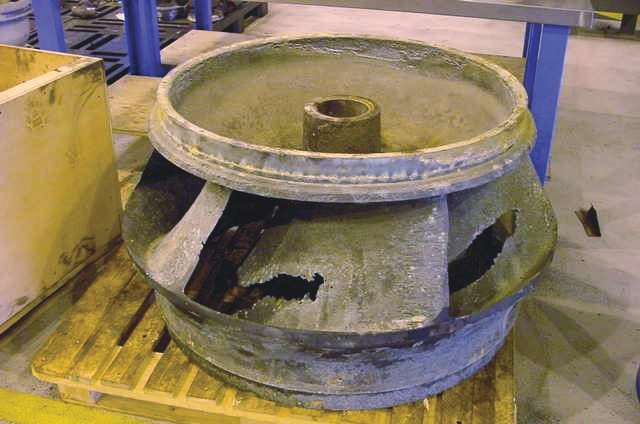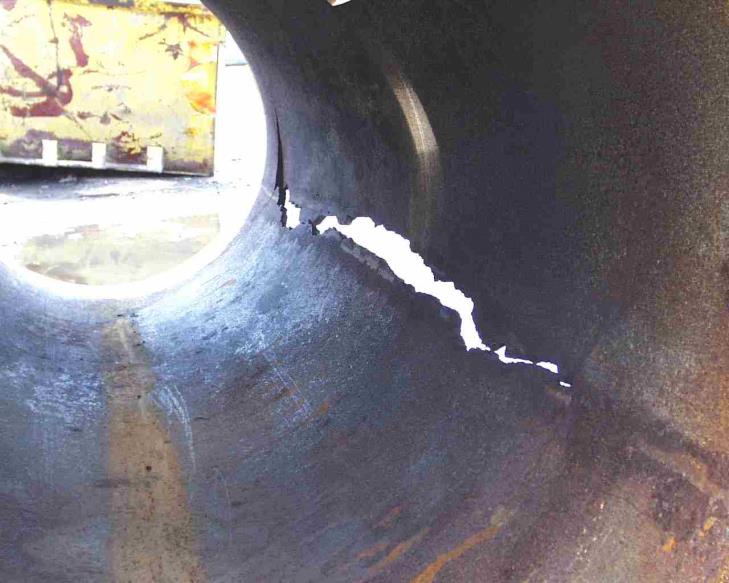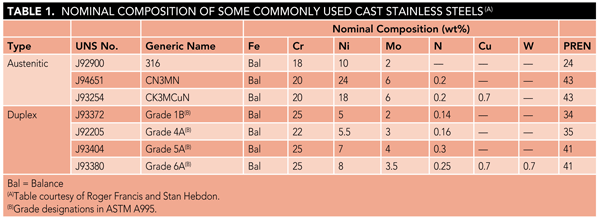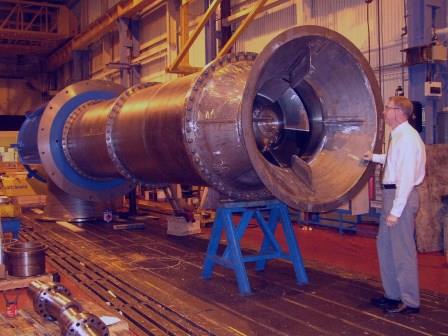With the ever-growing demand for potable water by growing populations worldwide, the need to conserve fresh water has led to the use of salt water, which is much more abundant. According to the U.S. Geological Survey (USGS), ~97.2% of Earth’s water is salt water, which is located mainly in the oceans and seas.1
Many industries worldwide—oil and gas production, desalination, power generation, etc.—handle seawater for one or more of their processes. In addition to being one of the most widely used cooling mediums in the world, seawater is used for applications such as the feedstock for reverse osmosis desalination, oil and gas field injection, mining, and firefighting. In the United States, ~15% of all water used in 2005 was salt water. Of that, over 95% was used by the thermoelectric power industry to cool electricity-generating equipment. The other 5% was used for mining (3%) and industrial applications (2%).1
Pumps are routinely used to handle seawater, with different pump designs utilized depending on the type of industrial service and the location of the plant. According to NACE International members Roger Francis, FNACE, corrosion consultant with RFMaterials (Glossop, United Kingdom) and Stan Hebdon, foundry and metallurgical consultant (Crewe, Cheshire, United Kingdom), these include seawater lift pumps, which are usually high-pressure multi-stage pumps on offshore oil production platforms that bring up seawater for cooling and well reinjection; circulation pumps, which are large-diameter, single-stage pumps that move sizeable volumes of water throughout very large plants at relatively low pressures; and firewater pumps, which are similar to lift pumps, but typically operate on standby and must start and work reliably in the event of an emergency.
Around the world, seawater varies in salt composition, from 10,000 mg/L of chlorides for brackish water to 19,000 mg/L of chlorides for open ocean water, says Francis. In confined areas with high temperatures, chloride concentrations can be as high as 25,000 mg/L; and in industrial processes such as reverse osmosis plants, which remove fresh water from seawater and leave a concentrated brine, chloride concentrations can be double that of natural seawater—around 35,000 to 40,000 mg/L. With the increasing demands for low maintenance and reliable operation, particularly in offshore locations, it is important that suitable corrosion- and erosion-resistant materials are selected for pumps used in seawater service. Cooling, seawater lift, and firewater pumps traditionally have been fabricated of copper (Cu) alloys such as gunmetals (alloys of Cu, tin [Sn], and zinc [Zn] that are resistant to corrosion from steam and salt water) and nickel aluminum bronze (NAB)—a Cu-based alloy with aluminum (Al), iron (Fe), nickel (Ni), and manganese (Mn). NAB is used for seawater service and is resistant to pitting corrosion, stress corrosion, and corrosion fatigue.
The drawbacks to these copper alloys, note Francis and Hebdon, are their susceptibility to erosion/corrosion at high water velocities and pitting corrosion in polluted, sulfide-containing waters. Sulfide is often created by sulfate-reducing bacteria (SRB) under local deaerated conditions such as those found in the bottom mud of a sea floor. When sulfide is mixed with aerated seawater, the mixture is very aggressive to copper alloys. For pumps that spend some time on standby in stagnant seawater, such as firewater pumps, corrosion from sulfide-polluted seawater can be a problem. Figure 1 shows severe corrosion of a NAB impeller after service in sulfide-polluted seawater.

Austenitic cast iron (ACI) has also been used to fabricate seawater pump cases that protect impellers made of Type 316 (UNS S31600) stainless steel (SS), particularly in recirculation pumps. ACI is a grey or ductile iron with lower carbon and silicon levels and around 20% Ni, added to create a stable austenitic structure at ambient temperatures. It is corrosion resistant in many aggressive media; however, it is susceptible to chloride stress corrosion cracking (SCC) in seawater, particularly in warmer seawater. Traditionally, ACI pump cases have lasted 10 or more years, Francis and Hebdon comment, but modern specifications have reduced wall thicknesses, which have increased stresses and shortened the time to failure. A SCC crack in an ACI pump column after two years of service in the Middle East is shown in Figure 2.

Corrosion issues such as these have led to a search for more reliable, corrosion-resistant materials of construction for pumps in seawater service. SS is an attractive alternative, and there is a range of cast SS that can be used to replace copper alloys and ACI. Not all SS grades, however, are suitable for use in seawater. If the wrong grade of SS is used, Francis notes, pump components can experience corrosion problems. Service experience over the last 30 years has shown that lower-alloy SS grades are particularly vulnerable to corrosion in seawater service, while high-alloy SS pumps have generally worked extremely well. In their CORROSION 2015 paper no. 5446, “The Selection of Stainless Steels for Seawater Pumps,” Francis and Hebdon examine several grades of SS and their suitability for seawater pumps.
Stainless Steel Corrosion in Seawater
According to Francis and Hebdon, several types of corrosion can affect SS in seawater and impact the material’s suitability for seawater pumps. Crevice corrosion, a localized form of corrosion, is the most common form of corrosion and is initiated by changes in local chemistry within a crevice. This type of corrosion is usually associated with a stagnant solution in the microenvironments that tend to occur in crevices. In a seawater pump, crevices can be found where seals, impellers, etc. are fastened to the shaft, and where flange faces are cast in for pipework connections.
Erosion corrosion, the degradation of the material’s surface due to the mechanical impact of an impinging liquid or particles suspended in the fast flowing liquid, can happen because of the high velocity of seawater in a pump. Mechanical erosion of the passive oxide layer on the steel’s surface renders it more susceptible to corrosion.
Cavitation, which occurs when a fluid’s operational pressure drops below its vapor pressure and causes gas pockets and bubbles to form and collapse, can happen when a pump is operated outside of its normal design parameters, such as too-high suction at the intake or throttling of the discharge. Bubbles that repeatedly collapse near the steel surface cause cyclic stress that can erode the steel over time, leaving the exposed metal surface vulnerable to corrosion.
Corrosion fatigue results from the combination of alternating or cycling stresses in a corrosive environment, and can affect seawater pump shafts. The fatigue process is thought to rupture the steel’s protective passive film, which allows the corrosion process to accelerate.
Sulfide pitting occurs when seawater is stagnant for extended periods. Aerobic bacteria quickly consume the dissolved oxygen and then anaerobic bacteria such as SRB become active. Sulfide can greatly accelerate localized attack of copper alloys, but typically does not have a significant effect on high-alloy SS corrosion in seawater; however, Francis notes that in brines containing hydrogen sulfide (H2S), superduplex SS may experience corrosion when temperatures are >100 °C and H2S is >100 mg/L.
SS Alloys Resistant to Corrosion in Seawater
SS is a steel alloy with a minimum weight content of 10.5% chromium (Cr), the least amount of Cr required to produce a passive chromium oxide (Cr2O3) film that prevents surface corrosion by blocking the diffusion of oxygen into the steel. There are thousands of SS varieties available today, says Francis. They are categorized by their crystalline microstructure, which can be ferritic, martensitic, austenitic, or duplex (a mixture of austenitic and ferritic).
Ferritic SS contains between 10.5% and 27% Cr with very little Ni. Generally, ferritic SS has better engineering properties than the austenitic grades; however, ferritic alloys are difficult to make in thick sections and are not as readily welded as the austenitic alloys. Martensitic SS is extremely strong and tough, but not as corrosion-resistant as austenitic and ferritic SS.
Austenitic SS contains a minimum of 16% Cr; and the austenitic 300 Series, with a composition of at least 18% Cr and 8% Ni, provides better resistance to corrosion. High-alloy superaustenitic SS grades are alloyed with higher amounts of molybdenum (Mo) (=6%) and Ni, and also contain some nitrogen (N), which gives them superior resistance to chloride pitting and crevice corrosion, as well as better resistance to SCC.
Duplex SS are differentiated from austenitic SS by a larger amount of Cr (19 to 32%), but less Mo (<5%) and Ni content. Superduplex grades typically have 25% Cr. Compared to the austenitic grades, high-alloy duplex SS grades have more strength and improved resistance to pitting, crevice corrosion, and SCC. The use of duplex SS is favored for seawater pumps, Francis says, because the steels’ corrosion-resistant properties are attained with an alloy content that is lower than austenitic grades that have similar performance, which makes the duplex SS more cost effective. The higher concentrations of Mo and Ni in the austenitic SS alloys make them significantly more expensive when compared with the duplex SS alloys.
In their paper, Francis and Hebdon list the common austenitic and duplex alloys for cast SS (Table 1). To compare the pitting corrosion resistance of various grades of austenitic and duplex stainless SS in chloride-containing solutions, a pitting resistance equivalent number (PREN) is assigned to them based on their chemical compositions.2

Typically, the PREN calculations are based on the Cr, Mo, N, and tungsten (W) content, as shown in Equation (1):
PREN = %Cr + 3.3 (%Mo + 0.5 × %W) + 16 × %N (1)
Francis and Hebdon comment that a strong correlation has been established between the PREN for particular types of SS and their resistance to crevice corrosion in seawater. In their paper, they cite several studies that support the following conclusions: a higher PREN indicates greater resistance to corrosion; only alloys with a PREN =40 will resist crevice corrosion in seawater; austenitic SS alloys need a higher PREN than duplex SS alloys to be resistant to crevice corrosion in seawater; and at various water temperatures (46 to 77 °F [8 to 25 °C]), austenitic SS grades with 6% Mo and superduplex SS grades with 25% Cr (both grades have a PREN =40) resisted corrosion attack under all conditions. According to NORSOK,3 alloys for seawater must have a PREN >40.
“The superduplex and the austenitic stainless steels with 6% molybdenum have proven corrosion resistance in seawater,” Francis says. “They’ve been used in the North Sea since the early 1990s.” He explains that the ferrite phase in the duplex SS alloys gives them strength, so they are at least 50% stronger than the austenitic SS alloyed with 6% Mo. Whether the extra strength is needed depends on the design of the seawater pump. “A seawater pump is a pressure vessel,” he says. “The seawater comes in at a low pressure and exits at a high pressure. The whole pump body has to be strong enough to resist that pressure.” Furthermore, he notes, the strength is needed to resist erosion-corrosion. Since duplex SS alloys are stronger than the austenitic SS, pumps cast of duplex SS can be designed with thinner castings to reduce the component’s weight and cost while retaining its strength.
Casting SS into Seawater Pump Components
While selecting the correct grade and type of SS is essential for fabricating a corrosion- resistant seawater pump, the quality of the casting is important as well. Francis and Hebdon point out in their paper that the foundry casting the pump components needs to have technical expertise and skill in handling these alloys so the final component will possess optimum corrosion resistance and mechanical properties along with a high degree of integrity within the casting. In several cases they have encountered corrosion problems caused by poor-quality castings.
“There are several areas that are going to affect the integrity of the casting in terms of its corrosion resistance in service. The first one is the actual chemistry,” Hebdon says, explaining that the founder must understand and adjust the metallurgical chemistry when formulating the alloy composition to achieve the ideal 50/50 balance of the ferrite and austenite phases for duplex SS. The foundry’s casting method—the way it will fill designs and fills the mold with molten metal—is also important for corrosion resistance. Most modern foundries use simulation techniques to model the filling and solidification of the casting before any metal is actually poured to avoid porosity, gas formation, or shrinkage, conditions that can aid corrosion, he observes.
Another key component of the casting process is heat treatment. One of the most common causes of problems in service is poor heat treatment, Hebdon comments. The duplex and superduplex grades are typically heated between 1,120 and 1,150 °C after solidification to produce a homogeneous microstructure that is free from precipitates and third phases. “These alloys must be solution annealed and given sufficient time at temperature so any adverse [third] phases that are formed during solidification are redissolved,” Hebdon notes. Third phases and precipitates can lower the alloy content locally in adjacent areas and, consequently, the PREN is also effectively reduced in these areas, making them very susceptible to pitting corrosion. After heat treatment, the casting must be quenched in a water bath so it cools as quickly as possible to prevent precipitates from reforming.
When castings need to be upgraded or repaired by welding, Hebdon adds, the correct welding parameters and procedures need to be followed, especially selection of the correct consumable with the appropriate alloy content, so the required microstructure is produced and the desired mechanical properties and corrosion resistance are achieved in the weld and heat-affected zone (HAZ). Otherwise, the corrosion resistance of the welded areas can be reduced relative to the base metal.
Several case studies that illustrate seawater pump failures due to material corrosion as well as the replacement materials and subsequent service experience, are discussed in the paper. One particular study describes a plant in Mexico that was compressing N from the atmosphere for injection into some gas wells for enhanced recovery. This involved a series of heat exchangers and pumps handling seawater from a shallow bay at various stages in the process. The seawater could contain up to 50,000 mg/L of sand when the bay water was agitated during tropical storms. This caused severe erosion of the NAB pumps, which were frequently failing. Francis and Hebdon were involved in replacing all the original pumps with superduplex pumps designed to cope with high loading of intermittent solids. These pumps were so large that castings for the cases would have been very difficult to make, and so the cases were fabricated from Z100 (UNS S32760) superduplex SS wrought plate, while the impellers were cast in Grade 6A (UNS J93380) superduplex SS. Figure 3 shows one of these pumps, which have now been in service for 10 years with excellent performance.

The use of duplex SS for seawater pumps is becoming widespread, Francis says, especially for offshore oil and gas platforms; floating production, storage, and offloading (FPSO) vessels; and desalination plants, particularly reverse osmosis desalination. There is a range of cast SS that can be used to replace copper alloys and ACI, but it’s important to select the correct SS grade for the service conditions. Superduplex SS offers the best combination of properties for these applications.
Bibliography
Francis R., and S. Hebdon. “The Selection of Stainless Steels for Seawater Pumps.” CORROSION 2015, paper no. 5446. Houston, TX: NACE International, 2015.
References
1 U.S. Geological Survey, The USGS Water Science School, Saline Water, Dec. 9, 2015, http://water.usgs.gov/edu/saline.html (Feb. 4, 2016).
2 ASTM A995/A995M-13, “Standard Specifications for Castings, Austenitic-Ferritic (Duplex) Stainless Steel, for Pressure- Containing Parts” (West Conshohocken, PA: ASTM, 2013).
3 NORSOK M-630, “Material data sheets and element data sheets for piping” (Lysaker, Norway: Standards Norway, 2010).